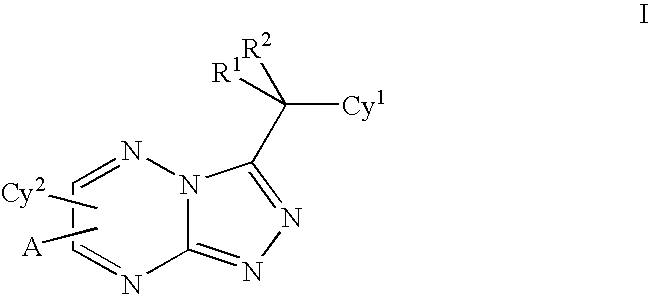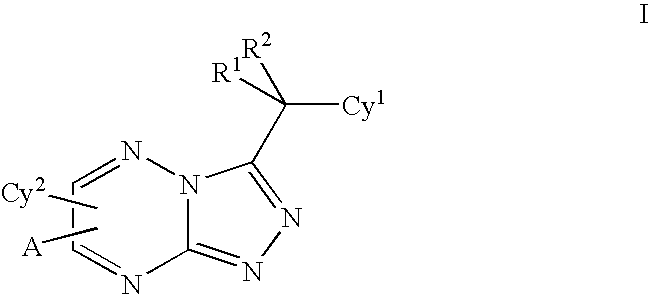Triazolotriazines as kinase inhibitors
a technology of kinase inhibitors and triazolotriazines, which is applied in the field of triazolotriazines as kinase inhibitors, can solve the problems of poor clinical outcomes, shortening patient survival, and no c-met inhibitors or antagonists currently available for treating human disorders, and achieves inhibition of activity and inhibiting the proliferative activity of cells
- Summary
- Abstract
- Description
- Claims
- Application Information
AI Technical Summary
Problems solved by technology
Method used
Image
Examples
example 1
3-[1-(4-Methoxyphenyl)cyclopropyl]-6-phenyl[1,2,4]triazolo[4,3-b][1,2,4]triazine and
3-[1-(4-Methoxyphenyl)cyclopropyl]-7-phenyl[1,2,4]triazolo[4,3-b][1,2,4]triazine
[0206]
Step 1. Methyl 1-(4-methoxyphenyl)cyclopropanecarboxylate
[0207]
[0208] 1-(4-Methoxyphenyl)cyclopropanecarboxylic acid (0.970 g, 5.05 mmol) in dichloromethane (DCM; 5 mL) was mixed with oxalyl chloride (1.28 mL, 15.1 mmol) followed by addition of a drop of N,N-dimethylformamide (DMF; 20 μL). The mixture was stirred at room temperature (RT) for 2 h. The solvent was evaporated. The residue was co-evaporated with toluene (2×), and dissolved in DCM (10 mL). The solution was cooled at −10° C., and then methanol (3 mL) was carefully added to the solution. The resulting mixture was allowed to warm to RT. The volatiles were evaporated under reduced pressure to afford the desired product (1.03 g, 99%).
Step 2. 1-(4-Methoxyphenyl)cyclopropanecarbohydrazide
[0209]
[0210] A mixture of methyl 1-(4-methoxyphenyl)cyclopropanecarbo...
example 2
4-[1-(6-Phenyl[1,2,4]triazolo[4,3-b][1,2,4]triazin-3-yl)cyclopropyl]phenol and
4-[1-(7-Phenyl[1,2,4]triazolo[4,3-b][1,2,4]triazin-3-yl)cyclopropyl]phenol
[0217]
[0218] To a mixture of 3-[1-(4-methoxyphenyl)cyclopropyl]-6-phenyl[1,2,4]triazolo[4,3-b][1,2,4]triazine (17.0 mg, 0.0495 mmol) and 3-[1-(4-methoxyphenyl)cyclopropyl]-7-phenyl[1,2,4]triazolo[4,3-b][1,2,4]triazine (17.0 mg, 0.0495 mmol) in DCM (3.0 mL) was added 1.00 M of boron tribromide in DCM (0.5 mL). The mixture was stirred at RT for 3 h. The solvent was evaporated. The residue was diluted with methanol (5 mL). The resulting mixture was subject to preparative RP-HPLC to give the two regioisomers. Analytical LCMS: (M+H)+=330.1. Isomer-I: Rt=1.451 min; Isomer-II: Rt=1.450 min.
example 3
6-(4-Fluorophenyl)-3-[1-(4-methoxyphenyl)cyclopropyl][1,2,4]triazolo[4,3-b][1,2,4]triazine and
7-(4-Fluorophenyl)-3-[1-(4-methoxyphenyl)cyclopropyl][1,2,4]triazolo[4,3-b][1,2,4]triazine
[0219]
[0220] The above two compounds were prepared using procedures analogous to those for Example 1. Analytical LCMS: (M+H)+=362.1. Isomer-I: Rt=1.832 min; Isomer-II: Rt=1.801 min.
PUM
| Property | Measurement | Unit |
|---|---|---|
| flow rate | aaaaa | aaaaa |
| temperature | aaaaa | aaaaa |
| temperature | aaaaa | aaaaa |
Abstract
Description
Claims
Application Information
 Login to View More
Login to View More - R&D
- Intellectual Property
- Life Sciences
- Materials
- Tech Scout
- Unparalleled Data Quality
- Higher Quality Content
- 60% Fewer Hallucinations
Browse by: Latest US Patents, China's latest patents, Technical Efficacy Thesaurus, Application Domain, Technology Topic, Popular Technical Reports.
© 2025 PatSnap. All rights reserved.Legal|Privacy policy|Modern Slavery Act Transparency Statement|Sitemap|About US| Contact US: help@patsnap.com



